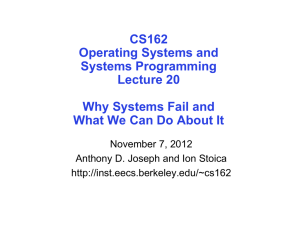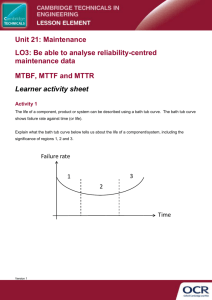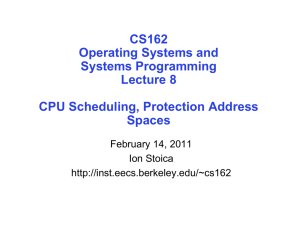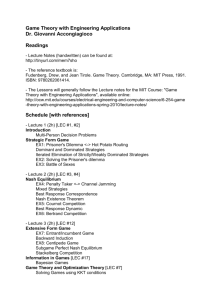Lecture 1: Course Introduction and Overview
advertisement
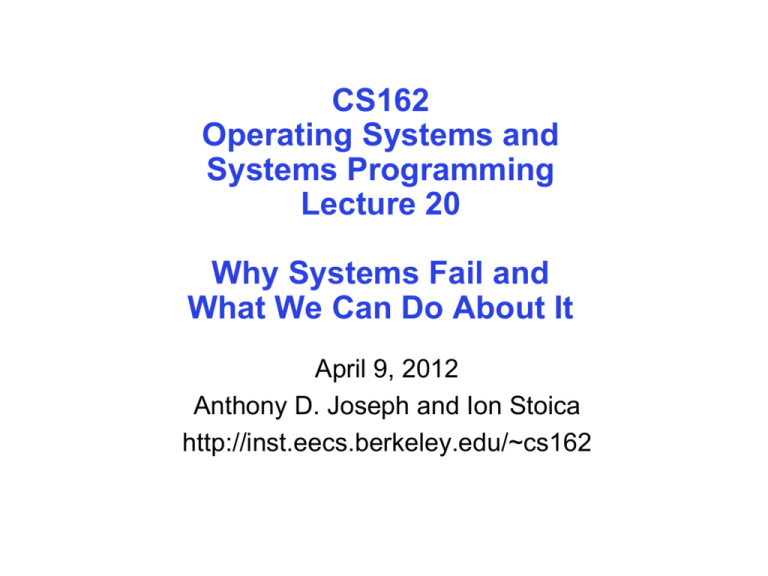
CS162 Operating Systems and Systems Programming Lecture 20 Why Systems Fail and What We Can Do About It April 9, 2012 Anthony D. Joseph and Ion Stoica http://inst.eecs.berkeley.edu/~cs162 Goals for Today • Definitions for Fault Tolerance • Causes of system failures • Possible solutions – Single system, Datacenter, geographic diversity “You know you have a distributed system when the crash of a computer you’ve never heard of stops you from getting any work done.” —LESLIE LAMPORT Note: Some slides and/or pictures in the following are adapted from slides from a talk given by Jim Gray at UC Berkeley on November 9, 2000. 04/09/2012 Anthony D. Joseph and Ion Stoica CS162 ©UCB Spring 2012 Lec 20.2 Dependability: The 3 ITIES • Reliability / Integrity: does the right thing. (Need large MTBF) • Availability: does it now. (Need small MTTR MTBF+MTTR) Integrity Reliability Security Availability • System Availability: if 90% of terminals up & 99% of DB up? (=> 89% of transactions are serviced on time) MTBF or MTTF = Mean Time Between (To) Failure MTTR = Mean Time To Repair 04/09/2012 Anthony D. Joseph and Ion Stoica CS162 ©UCB Spring 2012 Lec 20.3 Fault Tolerance versus Disaster Tolerance • Fault-Tolerance: mask local faults – Redundant HW or SW – RAID disks – Uninterruptible Power Supplies – Cluster Failover • Disaster Tolerance: masks site failures – Protects against fire, flood, sabotage,.. – Redundant system and service at remote site. – Use design diversity 04/09/2012 Anthony D. Joseph and Ion Stoica CS162 ©UCB Spring 2012 Lec 20.4 High Availability System Classes Availability % Downtime per year Downtime per month Downtime per week 90% (“one nine”) 36.5 days 72 hours 16.8 hours 99% (“two nines”) 3.65 days 7.20 hours 1.68 hours 99.9% (“three nines”) 8.76 hours 43.2 minutes 10.1 minutes 99.99% (“four nines”) 52.56 minutes 4.32 minutes 1.01 minutes 99.999% (“five nines”) 5.26 minutes 25.9 seconds 6.05 seconds 99.9999% (“six nines”) 31.5 seconds 2.59 seconds 0.605 seconds GOAL: Class 6 UnAvailability ~ MTTR/MTBF can cut it in ½ by cutting MTTR or MTBF 04/09/2012 Anthony D. Joseph and Ion Stoica CS162 ©UCB Spring 2012 Lec 20.5 Case Study – Japan “Survey on Computer Security”, Japan Info Dev Corp., March 1986. (trans: Eiichi Watanabe). Vendor 4 2% Telecomm lines 12 % 11.2 % Environment 2 5% Application Software 9.3% Operations Vendor (hardware and software) Application software Communications lines Operations Environment 5 9 1.5 2 2 10 Months Months Years Years Years Weeks 1,383 institutions reported (6/84 - 7/85) 7,517 outages, MTBF ~ 10 weeks, avg duration ~ 90 MINUTES To Get 10 Year MTBF, Must Attack All These Areas 04/09/2012 Anthony D. Joseph and Ion Stoica CS162 ©UCB Spring 2012 Lec 20.6 Case Studies - Tandem Trends Reported MTBF by Component Mean Time to System Failure (years) by Cause 450 400 maintenance 350 300 250 hardware environment 200 operations 150 100 software 50 total 0 1985 SOFTWARE HARDWARE MAINTENANCE OPERATIONS ENVIRONMENT SYSTEM 1987 1989 1985 1987 1990 2 29 45 99 142 53 91 162 171 214 33 310 409 136 346 Years Years Years Years Years 8 20 21 Years Problem: Systematic Under-reporting 04/09/2012 Anthony D. Joseph and Ion Stoica CS162 ©UCB Spring 2012 Lec 20.7 Operations Failures RAID Drive 1 failed! Replace immediately What went wrong?? 04/09/2012 Anthony D. Joseph and Ion Stoica CS162 ©UCB Spring 2012 Lec 20.8 Operations Failures RAID Drive 1 failed! Replace immediately 04/09/2012 Anthony D. Joseph and Ion Stoica CS162 ©UCB Spring 2012 Lec 20.9 Causal Factors for Unavailability Lack of best practices: • Change control • Monitoring of the relevant components • Requirements and procurement • Operations • Avoidance of network failures, internal application failures, and external services that fail • Physical environment, and network redundancy • Technical solution of backup, and process solution of backup • Physical location, infrastructure redundancy • Storage architecture redundancy 04/09/2012 Ulrik Franke et al: Availability of enterprise IT systems - an expert-based Bayesian model Lec 20.10 Anthony D. Joseph and Ion Stoica CS162 ©UCB Spring 2012 Cloud Computing Outages 2011 Vendor When Duration What Happened & Why Apple iPhone 4S Siri November 2011 1 Day Siri loses even the most basic functionality when Apples servers are down. Because Siri depends on servers to do the heavy computing required for voice recognition, the service is useless without that connection. Network outages caused the disruption according to Apple. Blackberry outage October 2011 3 Days Outage was caused by a hardware failure (core switch failure) that prompted a "ripple effect" in RIM's systems. Users in Europe, Middle East, Africa, India, Brazil, China and Argentina initially experienced email and message delays and complete outages and later the outages spread to North America too. Main problem is message backlogs and the downtime produced a huge queue of undelivered messages causing delays and traffic jams. Google Docs September 2011 1 Hour Google Docs word collaboration application cramp, shutting out millions of users from their document lists, documents, drawings and Apps Scripts. Outage was caused by a memory management bug software engineers triggered in a change designed to “improve real time collaboration within the document list. Windows Live services Hotmail & SkyDrive September 2011 3 Hours Users did not have any data loss during the outage and the interruption was due to an issue in Domain Name Service (DNS). Network traffic balancing tool had an update and the update did not work properly which caused the issue. Amazon’s EC2 cloud & August 2011 1-2 days Transformer exploded and caught fire near datacenter that resulted in power outage due to generator failure. Power back up systems at both the data centers failed causing power outages. Transformer explosion was caused by lightening strike but disputed by local utility provider. Microsoft’s BPOS August 2011 1-2 days Transformer exploded and caught fire near datacenter that resulted in power outage due to generator failure. Power back up systems at both the data centers failed causing power outages. Transformer explosion was caused by lightening strike but disputed by local utility provider. From: http://analysiscasestudy.blogspot.com/ 04/09/2012 Anthony D. Joseph and Ion Stoica CS162 ©UCB Spring 2012 Lec 20.11 Cloud Computing Outages 2011 Vendor When Duration What Happened & Why Amazon Web Services April, 2011 4 Days During the upgrade, the traffic shift was executed incorrectly and rather than routing the traffic to the other router on the primary network, the traffic was routed onto the lower capacity redundant EBS network. This led to Amazon Elastic Block Store (“EBS”) volumes in a single Availability Zone within the US East Region that became unable to service read and write operations. It also impacted the Relational Database Service (“RDS”). RDS depends upon EBS for database and log storage, and as a result a portion of the RDS databases hosted in the primary affected Availability Zone became inaccessible. Microsoft BPOS Outages May 2011 2 Hours Paying customers' email was delayed by as much as nine hours. Delay as outgoing messages started getting stuck in the pipeline. Twitter Outages March & Feb 2011 1-4 Hours Outages due to over capacity and moving operations to new data center. Intuit Quick Books Online March 2011 2 Days Service failures on human error during scheduled maintenance operations. Inuit changed its network configuration and inadvertently blocked customer access to a portion of the company’s servers. A surge in traffic overloaded the servers when connectivity was restored, so the company opted to restore service. Google Mail and Apps Outage February 2011 2 Days Google mail and Google Apps users experienced login errors and empty mailboxes. Google Engineering determined that the root cause was a bug inadvertently introduced in a Gmail storage software update. The bug caused the affected users’ messages and account settings to become temporarily unavailable from the datacenters. From: http://analysiscasestudy.blogspot.com/ 04/09/2012 Anthony D. Joseph and Ion Stoica CS162 ©UCB Spring 2012 Lec 20.12 Cloud Computing Outages 2010 Vendor When Duration What Happened & Why Hotmail Outage December 2010 3 Days A number of our users reported their email messages and folders were missing from their Hotmail accounts. Error occurred from a script that was meant to delete dummy accounts created for automated testing and it mistakenly targeted 17,000 real accounts instead. Skype Outage December 2010 1 Day Cluster of support servers responsible for offline instant messaging became overloaded and the P2P network became unstable and suffered a critical failure. A supernode is important to the P2P network acting like a directory, supporting other Skype clients, helping to establish connections between them etc. The failure of 25–30% of supernodes in the P2P network resulted in an increased load on the remaining supernodes. Paypal Outage November 2010 3 Hours A network hardware failure was the trigger for an outage. The hardware failure was worsened by problems in shifting traffic to another data center, resulting in about 90 minutes of downtime. Facebook Outage September 2010 2½ Hours Outage due to an error condition. An automated system for verifying configuration values ended up causing much more damage than it fixed. Every single client saw the invalid value and attempted to fix it that led to a query to a database cluster and cluster was overloaded with thousand of queries per second. Even after fixing problem stream of queries continued. Microsoft BPOS Outages August & September 2010 2 Hours A design issue in the upgrade that caused unexpected impact, but the issue resulted in a 2-hour period of intermittent access for BPOS organizations served from North America. Wikipedia Outage July & March 2010 2-3 Hours In July, the power failure is understood to have affected Wikimedia's 'pmtpa' cluster. Due to the temporary unavailability of several critical systems and the large impact on the available systems capacity, all Wikimedia projects went down. In March, Wikimedia servers overheated in the organization's European data center and shut themselves off automatically. Wikimedia then switched all its traffic to its server cluster in Florida, but the failover process, which involves changing servers' DNS entries, malfunctioned, knocking the organization's sites offline around the world. Hosting.com Outage June 2010 2 Hours Failure of a Cisco switch at the Newark, N.J., data center caused intermittent network connectivity. Dedicated switch had failed, the second failover switch had crashed as well and the problem was caused by a software bug. Twitter.com outage June 2010 5 hours Increased activity on the site, combined with system enhancements and upgrades, have uncovered networking issues. Incidences of poor site performance and a high number of errors due to one of the internal sub-networks being over-capacity. 04/09/2012 Anthony D. Joseph and Ion Stoica CS162 ©UCB Spring 2012 Lec 20.13 Cloud Computing Outages 2009 Vendor When Duration What Happened & Why Salesforce.com Outage January 2010, 2009 1-2 Hours Outages were caused by server disruption, when a core network device failed, stopping all data from being processed in Japan, Europe, and North America. The technical reason for the outage: a core network device had failed, due to memory allocation errors. The backup plan, which was supposed to trigger a cut-over to a redundant system, also failed. Amazon’s EC2 June 2009 4-5 Hours A lightning storm caused damage to a single Power Distribution Unit (PDU) in a single Availability Zone eBay Paypal August 2009 1-4 Hours Online payments system failed a couple of times led to non completion of transactions. Network hardware issue is blamed for outage. Twitter August 2009 ½ Day A denial-of-service attack was blamed for the problem Google Gmail September 2009 2 hours 2 times Reasons from vendors include routing errors to server maintenance issues. Microsoft Sidekick October 2009 6 days Microsoft’s Danger server farm, that holds the cloud T-Mobile Sidekick subscriber’s data crashed, depriving users of their calendar, address book, and other key data. Critical data was lost during outage. Rackspace.co m Outage June 2009 1 Day December 2009 1 Hour Power outage and subsequent power generator failures that caused servers to fail. Company was forced to pay out between $2.5 million and $3.5 million in service credits to customers. The issues resulted from a problem with a router used for peering and backbone connectivity located outside the data center at a peering facility, which handles approximately 20% of Rackspace's Dallas traffic. The router configuration error was part of final testing for data center integration between the Chicago and Dallas facilities. From: http://analysiscasestudy.blogspot.com/ 04/09/2012 Anthony D. Joseph and Ion Stoica CS162 ©UCB Spring 2012 Lec 20.14 Fault Model • Failures are independent* So, single fault tolerance is a big win • Hardware fails fast (blue-screen, panic, …) • Software fails-fast (or stops responding/hangs) • Software often repaired by reboot: – Heisenbugs – Works On Retry – (Bohrbugs – Faults Again On Retry) • Operations tasks: major source of outage – Utility operations – UPS/generator maintenance – Software upgrades, configuration changes 04/09/2012 Anthony D. Joseph and Ion Stoica CS162 ©UCB Spring 2012 Lec 20.15 Some Fault Tolerance Techniques • Fail fast modules: work or stop • Spare modules: yield instant repair time • Process/Server pairs: Mask HW and SW faults • Transactions: yields ACID semantics (simple fault model) 04/09/2012 Anthony D. Joseph and Ion Stoica CS162 ©UCB Spring 2012 Lec 20.16 Fail-Fast is Good, Repair is Needed Lifecycle of a module fail-fast gives short fault latency High Availability is low UN-Availability Unavailability ~ MTTR MTBF Improving either MTTR or MTBF gives benefit Simple redundancy does not help much 04/09/2012 Anthony D. Joseph and Ion Stoica CS162 ©UCB Spring 2012 Lec 20.17 Hardware Reliability/Availability (how to make HW fail fast) Basic FailFast Designs Pair Triplex Recursive Designs Recursive Availability Designs Triple Modular Redundancy Pair & Spare + + Comparitor Strategies: (in recursive pairs, parent knows which is bad) Duplex: Fail-Fast: fail if either fails (e.g. duplexed CPUs) vs Fail-Soft: fail if both fail (e.g. disc, network,...) Triplex: Fail-Fast: fail if 2 fail (triplexed cpus) Fail-Soft: fail if 3 fail (triplexed FailFast CPUs) 04/09/2012 Anthony D. Joseph and Ion Stoica CS162 ©UCB Spring 2012 Lec 20.18 Redundant Designs have Worse MTBF! Duplex: fail fast TMR: fail fast mttf/2 5/6*mttf mttf/1 mttf/2 mttf/3 0 work 1 work 2 work Duplex: fail soft TMR: fail soft 1.5*mttf mttf/2 11/6*mttf mttf/1 mttf/3 0 work 1 work 2 work 3 work Pair & Spare: fail fast mttf/4 0 3 work mttf/1 mttf/2 0 work 1 work 2 work Pair & Spare: fail soft ~2.1*mttf mttf/4 4 work mttf/3 3 work mttf mttf/2 2 work 1 work mttf/2 2 work mttf/1 1 work 0 work The Airplane Rule: 3/4*mttf 4 work 0 work 1 work 2 work 3 work mttf/1 mttf/2 0 work A two-engine airplane has twice as many engine problems as a one engine plane THIS IS NOT GOOD: Variance is lower but MTBF is worse Simple redundancy does not improve MTBF (sometimes hurts) 04/09/2012 Anthony D. Joseph and Ion Stoica CS162 ©UCB Spring 2012 Lec 20.19 Add Repair: Get 104 Improvement Duplex: fail fast: mtbf/2 2 work mttf/2 1 mttr work Duplex: fail soft TMR: fail fast mttf/3 mttf/1 mttr 0 work 4 10 mttf mttf/2 1 2 work mttr work 3 work mttr mttf/2 2 work TMR: fail soft mttf/3 mttf/1 0 work mttr 4 10 mttf 3 work 1 mttr work 0 mttr work 5 10 mttf mttf/2 2 1 work work mttf/2 mttr mttr mttf/1 Availability estimates 1 year MTTF modules 12-hour MTTR MTTF EQUATION SIMPLEX 1 year MTTF DUPLEX: ~0.5 - MTTF/2 FAIL FAST years DUPLEX: FAIL ~1.5 - MTTF(3/2) SOFT years TRIPLEX: .8 year - MTTF(5/6) 0 work mttr FAIL FAST TRIPLEX: FAIL SOFT 04/09/2012 1.8 year Pair and spare: ~. 7 FAIL -FAST year TRIPLEX WITH >105 REPAIR years Duplex fail soft + >104 Anthony D. Joseph and Ion Stoica CS162 ©UCB Spring 2012 REPAIR years 20 COST 1 2+ 2+ 3+ - 1.8MTTF 3+ - MTTF(3/4) 4+ MTTF3/3MTTR 3+ 2 MTTF2/2MTTR 4+ Lec 20.20 Software Techniques: Learning from Hardware • • • • Recall that most outages are not hardware Most outages in Fault Tolerant Systems are SOFTWARE Fault avoidance techniques: Good & Correct design After that: Software Fault Tolerance Techniques: Modularity (isolation, fault containment) N-Version Programming: N-different implementations Programming for Failures: Programming paradigms that assume failures are common and hide them Defensive Programming: Check parameters and data Auditors: Check data structures in background Transactions: to clean up state after a failure Paradox: Need Fail-Fast Software 04/09/2012 Anthony D. Joseph and Ion Stoica CS162 ©UCB Spring 2012 Lec 20.21 Fail-Fast and High-Availability Execution Process Pairs: Instant restart (repair) Use Defensive programming to make a process fail-fast Have restarted process ready in separate environment Second process “takes over” if primary faults • If software fault (bug) is a Bohrbug, then there is no repair “wait for the next release” or “get an emergency bug fix” or “get a new vendor” • If software fault is a Heisenbug, then repair is “reboot and retry” or “switch to backup process (instant restart)” • Tolerates HW faults too! • Millisecond repair times LOGICAL PROCESS = PROCESS PAIR SESSION PRIMARY PROCESS STATE INFORMATION BACKUP PROCESS 04/09/2012 22 Anthony D. Joseph and Ion Stoica CS162 ©UCB Spring 2012 Lec 20.22 Server System Pairs for High Availability Primary Backup • Programs, Data, Processes Replicated at 2+ sites – Pair looks like a single system • System becomes logical concept – Like Process Pairs: System Pairs. • Backup receives transaction log (spooled if backup down) • If primary fails or operator switches, backup offers service 04/09/2012 Lec 20.23 Anthony D. Joseph and Ion Stoica CS162 ©UCB Spring 2012 Administrivia • Project 3 code due Thu 4/12 at 11:59pm • Final exam Fri 5/11 11:30-2:30pm in 145 Dwinelle – Comprehensive, closed book/notes – Two double-sided handwritten pages of notes allowed • PSA: Backups! – World Backup Day was March 31st – Perform regular local backups – Test recovering a file – File vs disaster recovery – Offsite options: box.net, Dropbox (http://db.tt/k3A3n3T) 04/09/2012 Anthony D. Joseph and Ion Stoica CS162 ©UCB Spring 2012 Lec 20.24 5min Break 04/09/2012 Anthony D. Joseph and Ion Stoica CS162 ©UCB Spring 2012 Lec 20.25 Datacenter is new “server” • • • • “Program” == Web search, email, map/GIS, … “Computer” == 1000’s computers, storage, network Warehouse-sized facilities and workloads New datacenter ideas (2007-2008): truck container (Sun), floating (Google), datacenter-in-a-tent (Microsoft) 26 photos: Sun Microsystems & datacenterknowledge.com 04/09/2012 Anthony D. Joseph and Ion Stoica CS162 ©UCB Spring 2012 Lec 20.26 Datacenter Architectures • Major engineering design challenges in building datacenters – One of Google’s biggest secrets and challenges – Facebook creating open solution: http://www.facebook.com/note.php?note_id=101501480 03778920 – Very hard to get everything correct! • Example: AT&T Miami, Florida Tier 1 datacenter – Minimum N+1 redundancy factor on all critical infrastructure systems (power, comms, cooling, …) – Redundant communications: dual uplinks to AT&T global backbone – What about power? 04/09/2012 Anthony D. Joseph and Ion Stoica CS162 ©UCB Spring 2012 Lec 20.27 Typical Tier-2 One Megawatt Datacenter Main Supply Transformer ATS Switch Board 1000 kW UPS Generator Generator, Dual UPS UPS … STS PDU Panel Panel 50 kW Circuit 04/09/2012 Rack 2.5 kW • Units of Aggregation – Rack (10-80 nodes) → PDU (20-60 racks) → Facility/Datacenter STS PDU 200 kW • Reliable power: Mains + • Power is 40% of DC costs • Over 20% of entire DC costs is in power redundancy X. Fan, W-D Weber, L. Barroso, “Power Provisioning for a Warehouse-sized Computer,” ISCA’07, San Diego, (June 2007). Anthony D. Joseph and Ion Stoica CS162 ©UCB Spring 2012 Lec 20.28 AT&T Internet Data Center Power Commercial Power Feeds 2 commercial feeds, Each at 13,800VAC Located near Substation supplied from 2 different grids 04/09/2012 AT&T Enterprise Hosting Services briefing 10/29/2008 Lec 20.29 Anthony D. Joseph and Ion Stoica CS162 ©UCB Spring 2012 AT&T Internet Data Center Power • Paralleling switch gear • Automatically powers up all generators when Commercial power is interrupted for more than 7 seconds – Generators are shed to cover load as needed – Typical transition takes less than 60 seconds • Manual override available to ensure continuity if automatic start-up should fail 04/09/2012 Emergency Power Switchover AT&T Enterprise Hosting Services briefing 10/29/2008 Lec 20.30 Anthony D. Joseph and Ion Stoica CS162 ©UCB Spring 2012 AT&T Internet Data Center Power Back-up Power – Generators and Diesel Fuel • Four (4) 2,500 kw Diesel Generators Providing Standby Power, capable of producing 10 MW of power • Two (2) 33,000 Gallon Aboveground Diesel Fuel Storage Tanks 04/09/2012 Lec 20.31 Anthony D. Joseph and Ion Stoica CS162 ©UCB Spring 2012 AT&T Enterprise Hosting Services briefing 10/29/2008 AT&T Internet Data Center Power • UPS consisting of four battery strings • Battery strings contain flooded cell Lead Acid batteries • A minimum of 15 minutes of battery backup available at Full load • Remote status monitoring of battery strings 04/09/2012 UPS Batteries AT&T Enterprise Hosting Services briefing 10/29/2008 Lec 20.32 Anthony D. Joseph and Ion Stoica CS162 ©UCB Spring 2012 AT&T Internet Data Center Power • Motor-Generator pairs clean power • Eliminate spikes, sags, surges, transients, and all other Over/Under voltage And frequency conditions Uninterruptible Power Supply (UPS) • Four UPS Modules connected in a Ring Bus configuration • Each Module rated at 1000kVA • Rotary Type UPS by Piller 04/09/2012 AT&T Enterprise Hosting Services briefing 10/29/2008 Lec 20.33 Anthony D. Joseph and Ion Stoica CS162 ©UCB Spring 2012 Alternate Power Distribution Model • Google and Facebook replaced central UPS with individual batteries* 277 VAC FB 48VDC FB 04/09/2012 Anthony D. Joseph and Ion Stoica CS162 ©UCB Spring 2012 Lec 20.34 Add Geographic Diversity to Reduce Single Points of Failure* Can we eliminate internal redundancy – generators and UPS’s? 04/09/2012 Anthony D. Joseph and Ion Stoica CS162 ©UCB Spring 2012 Lec 20.35 Software Fault Tolerance: MapReduce • First widely popular programming model for dataintensive apps on commodity clusters • Published by Google in 2004 – Processes 20 PB of data / day • Popularized by open-source Hadoop project – 40,000 nodes at Yahoo!, 70 PB at Facebook • Programming model – Data type: key-value records » Map function: (Kin, Vin) list(Kinter, Vinter) » Reduce function: (Kinter, list(Vinter)) list(Kout, Vout) 04/09/2012 Anthony D. Joseph and Ion Stoica CS162 ©UCB Spring 2012 Lec 20.36 Word Count Execution Input the quick brown fox the fox ate the mouse Map Map Shuffle & Sort the, 1 brown, 1 fox, 1 Map Map Output Reduce brown, 2 fox, 2 how, 1 now, 1 the, 3 Reduce ate, 1 cow, 1 mouse, 1 quick, 1 the, 1 fox, 1 the, 1 how, 1 now, 1 brown, 1 how now brown cow 04/09/2012 Reduce quick, 1 ate, 1 mouse, 1 cow, 1 Anthony D. Joseph and Ion Stoica CS162 ©UCB Spring 2012 Lec 20.37 Fault Tolerance in MapReduce 1. If a task crashes: – Retry on another node » OK for a map because it had no dependencies » OK for reduce because map outputs are on disk – If the same task repeatedly fails, fail the job Note: For the fault tolerance to work, tasks must be deterministic and sideeffect-free 04/09/2012 Anthony D. Joseph and Ion Stoica CS162 ©UCB Spring 2012 Lec 20.38 Fault Tolerance in MapReduce 2. If a node crashes: – Relaunch its current tasks on other nodes – Relaunch any maps the node previously ran » Necessary because their output files are lost 04/09/2012 Anthony D. Joseph and Ion Stoica CS162 ©UCB Spring 2012 Lec 20.39 Fault Tolerance in MapReduce 3. If a task is going slowly (straggler): – Launch second copy of task on another node – Take output of whichever copy finishes first • Critical for performance in large clusters 04/09/2012 Anthony D. Joseph and Ion Stoica CS162 ©UCB Spring 2012 Lec 20.40 Takeaways • By providing a data-parallel programming model, MapReduce can control job execution in useful ways: – Automatic division of job into tasks – Placement of computation near data – Load balancing – Recovery from failures & stragglers 04/09/2012 Anthony D. Joseph and Ion Stoica CS162 ©UCB Spring 2012 Lec 20.41 Issues with MapReduce • Hard to express more complex programs – E.g. word count + a sort to find the top words – Need to write many different map and reduce functions that are split up all over the program – Must write complex operators (e.g. join) by hand • Acyclic data flow -> poor support for applications that need to reuse pieces of data – Iterative algorithms (e.g. machine learning, graphs) – Interactive data mining (e.g. Matlab, Python, SQL) • Alternative: Spark programming paradigm 04/09/2012 Anthony D. Joseph and Ion Stoica CS162 ©UCB Spring 2012 Lec 20.42 Apache ZooKeeper • Highly available, scalable, distributed coordination kernel – Leader Election, Group Membership, Work Queues, Sharding – Event Notifications/workflow, Config, and Cluster Mgmt • Provides: – File API without partial reads/writes and no renames – Ordered updates and strong persistence guarantees – Conditional updates (version), Watches for data changes • API: – String create(path, data, acl, flags) – void delete(path, expectedVersion) – Stat setData(path, data, expectedVersion) – (data, Stat) getData(path, watch) – Stat exists(path, watch) – String[] getChildren(path, watch) 04/09/2012 Anthony D. Joseph and Ion Stoica CS162 ©UCB Spring 2012 Lec 20.43 ZooKeeper Service Leader Server Server Server Server Server Server Client Client Client Client Client Client Client • All servers store a copy of the data (in memory) • A leader is elected at startup, or upon current leader failure • Followers service clients, all updates go through leader • Update responses are sent when a majority of servers have persisted the change 04/09/2012 Anthony D. Joseph and Ion Stoica CS162 ©UCB Spring 2012 Lec 20.44 Summary • Focus on Reliability/Integrity and Availability – Also, Security (see next two lectures) • Use HW/SW Fault-Tolerance techniques to increase MTBF and reduce MTTR – Assume the unlikely is likely • Make operations bulletproof: configuration changes, upgrades, new feature deployment, … • Apply replication at all levels (including globally) • Leverage software to build reliable systems from unreliable components 04/09/2012 Anthony D. Joseph and Ion Stoica CS162 ©UCB Spring 2012 Lec 20.45

